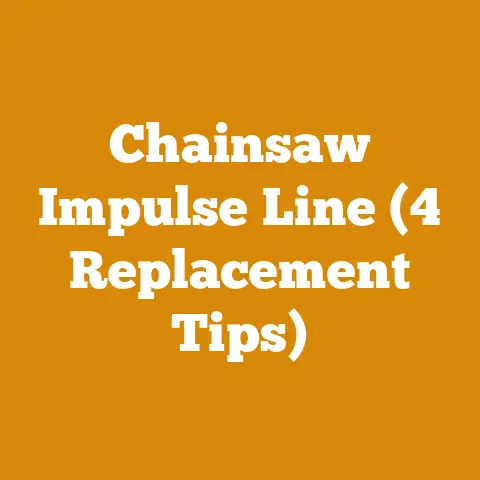How to Fix Stripped Threads (3 Quick Solutions)
My Chainsaw Adventure
A few springs ago, I faced a stripped thread situation that nearly derailed my entire weekend project.
I had planned a glorious day of clearing fallen branches and tidying up my yard.
Everything was set; the weather was perfect, the chainsaw was fueled up, and then—disaster.
The bolt refused to tighten, spinning aimlessly with no grip.
Have you ever faced such frustration? It’s like being all dressed up with nowhere to go.
But through trial, error, and a bit of luck, I found my way through it.
Let me share what I’ve learned, so you don’t have to experience the same headache.
Prerequisites and Required Materials
Before diving into the solutions, let’s prepare ourselves with the necessary background knowledge and gather the tools and materials we’ll need.
Working with power tools requires caution.
Always wear safety goggles and gloves to protect yourself from metal shavings and sharp edges.
Ensure your workspace is well-lit and free from obstructions to prevent accidents.
Solution 1: Mastering the HeliCoil Kit
The HeliCoil kit is an ingenious invention that has saved many a project from disaster.
It allows you to create new threads within a damaged hole by inserting a coil that mimics the original threading.
Steps:
- Identify the Thread Size:
Start by determining the size of the damaged thread.
This will guide your choice of drill bit, tap, and coil insert size. - Drill Out the Damaged Threads:
Use the specific drill bit provided in your HeliCoil kit.
Carefully remove the old threads by drilling straight into the hole.
It’s crucial to maintain alignment to avoid enlarging the hole unnecessarily. - Tap New Threads:
With precision, use the tap from your kit to cut new threads into the drilled hole.
This step requires patience and care—move slowly and apply consistent pressure.
A crooked tap can lead to further complications. - Insert the Coil:
Using the insertion tool provided in your kit, wind the HeliCoil insert into place.
It’s important to align it properly with the new threads for maximum effectiveness. - Break the Tang:
Once inserted, use a punch or similar tool to break off the tang at the bottom of the coil.
This step ensures that the coil remains secure within the threads.
In-Depth Tips:
- Practice Makes Perfect: If this is your first time using a HeliCoil kit, practice on a piece of scrap material before working on your chainsaw.
- Precision Matters: Double-check the drill bit size against your kit instructions to ensure compatibility.
A mismatch can lead to improper threading. - Lubrication is Key: Apply cutting oil during tapping to reduce friction and extend the life of your tools.
Solution 2: The Epoxy Quick Fix
Epoxy serves as an emergency solution for stripped threads when time is of the essence or when you’re in a location where more sophisticated tools aren’t available.
Steps:
- Clean the Area Thoroughly:
Before applying epoxy, clean the stripped area meticulously using a degreaser or alcohol-based cleaner.
Any residue can compromise epoxy adhesion. - Mix Epoxy Properly:
Follow mixing instructions diligently.
Precision in mixing ratios ensures optimal strength and bonding properties. - Apply Epoxy Generously:
Fill the stripped hole with epoxy, ensuring an even coat that reaches all areas of damage.
Be careful not to overfill—it can lead to overflow when reinserting the bolt. - Insert Bolt Carefully:
As the epoxy begins to set, gently screw in the original bolt.
Align it perfectly to avoid creating new damage.
Hold it steady until it sets enough to support itself. - Allow Full Cure Time:
Patience is crucial here.
Allow the epoxy to cure fully according to package instructions before using your chainsaw again.
Cautions and Considerations:
- Temporary Fix Alert: Remember that epoxy is not as durable as mechanical fixes like HeliCoil or re-tapping.
- Avoid Over-Tightening: Once cured, avoid over-tightening bolts as this can lead to premature failure.
- Temperature Sensitivity: Be aware that extreme temperatures can affect epoxy performance; plan accordingly.
Solution 3: Tap and Die Set Mastery
Using a tap and die set requires finesse but offers a reliable solution when executed correctly.
This method involves recutting threads within a stripped hole.
Steps:
- Select Appropriate Tap Size:
Match your tap size carefully with your original bolt size for an accurate threading process. - Clean and Prepare Hole:
Remove any debris or old thread remnants from the hole using a brush or compressed air. - Re-tap Threads with Precision:
Insert the tap into your hole and apply gradual pressure while turning it clockwise.
Maintain steady alignment with existing threads for best results. - Remove Metal Shavings:
After re-tapping, use compressed air or a brush to clear away any metal shavings that may have accumulated during threading. - Test with Original Bolt:
Gently screw in your original bolt; check for smoothness in threading without excessive resistance or wobbling.
Pro Tips for Success:
- Use Cutting Oil Generously: Applying cutting oil during tapping reduces tool wear and ensures smoother operation.
- Double Check Alignment: Misalignment can cause cross-threading—take time aligning before tapping.
- Feel for Resistance: If you encounter resistance during tapping, back out slightly before proceeding—forcing can cause further damage.
Addressing Common Questions & Concerns
Q1: Can I use a larger bolt instead?
A: While using a larger bolt might seem like a quick fix, it often requires enlarging holes beyond their intended size—something best avoided unless absolutely necessary due to potential structural integrity issues.
Q2: How long will epoxy hold?
A: Epoxy provides temporary reinforcement but lacks longevity compared to mechanical solutions like helicoil inserts which offer more durable repairs over time under normal operating conditions.
Q3: What if I don’t have these tools?
A: Many hardware stores offer tool rental services or professional repair options if purchasing isn’t feasible—consider exploring these avenues if needed!
Important Reminders & Next Steps
Ensuring reliable operation post-repair hinges upon careful execution paired with ongoing maintenance practices aimed at preventing future occurrences of stripped threads!
Maintain Regular Checks: Routinely inspect all bolts/nuts on equipment—tighten as necessary while avoiding over-tightening which contributes significantly towards stripping incidents!
Invest in Quality Tools/Materials: High-quality tools/materials translate directly into better outcomes across repairs while minimizing risks associated with subpar alternatives!
Plan Ahead for Future Repairs/Upgrades: Proactively planning future repairs/upgrades ensures readiness when unexpected challenges arise—equipping oneself adequately saves both time/money long-term!
Extended FAQ Section
Q1: Can I prevent threads from stripping in future?
A: Absolutely!
Regular maintenance checks coupled with proper torque application techniques go far towards minimizing risk factors associated with stripping incidents!
Q2: Is there special lubricant recommended specifically for threads?
A: Anti-seize lubricants are designed specifically for reducing friction between metal surfaces—ideal choice when aiming towards minimizing thread wear over prolonged periods!
Q3: What’s considered best long-term solution available currently?
A: HeliCoil inserts remain top choice due largely towards their durability coupled alongside ease-of-installation compared against other alternatives present today!
By following these steps carefully while keeping safety considerations top-of-mind throughout each phase involved within repair processes outlined above—you’ll find yourself well-equipped tackling even most challenging scenarios head-on confidently moving forward!






